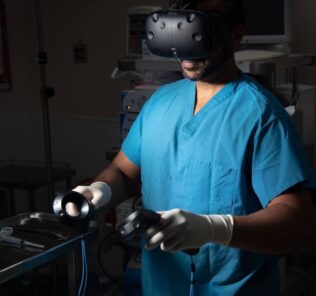IPE vs. Multidisciplinary Education: What’s the Difference for Clinical Simulation (w/ Downloadable Tool)
Defining interprofessional education (IPE) and distinguishing the term from multidisciplinary education is challenging since so many different definitions for both terms are found in the literature. However, the distinction is important when it comes to healthcare simulation — maybe so much so that we might even need a new term! Here guest author Dr. Kim Baily PhD, MSN, RN, CNE, previous Simulation Coordinator for Los Angeles Harbor College and Director of Nursing for El Camino College, explores the two terms and what they mean for medical simulation.
Also, don’t forget to download the free tool from IPEC below!
Usha Asirvatham, Denise Foy, and Torrey Laack from the Mayo Clinic Multidisciplinary Simulation Center presented a wonderful workshop at the recent IMSH 2020 meeting which focused on the meaning of these terms. They compared the difference between the attitudes, knowledge, behaviors of Interprofessional (IP) and multidisciplinary care teams.
Sponsored Content:
Attitudes
- Multidisciplinary: Each person is focused on own discipline specific plan of care. Some disciplines are thought to be more suitable for team leadership roles.
- Interprofessional: A biopsychosocial model which includes team discussions on group processes in addition to patient care. Team development is encouraged and supported and there is shared leadership.
Knowledge
- Multidisciplinary: Knows core patient care functions of other disciplines but knows own discipline well. Recognizes team leader and others’ responsibilities.
- Interprofessional: Knows training and competencies of other disciplines. Is able to articulate role overlap and unique contributions.
Behaviors:
- Multidisciplinary: Own assessment and treatment plans. Evaluates progress on their own.
- Interprofessional: Joint assessment and treatment plans. Identifies role overlaps in an attempt to avoid duplication and enhance coverage.
The presenters suggested that multidisciplinary care is hierarchical where everyone is working on the same problem within their own silos. Members have limited knowledge of other disciplines & roles and there is limited communication between members. For example, a pulmonologist, an infection control specialist and a cardiologist may all care for the same patient with pneumonia but have limited communication between themselves. In addition, there is no direct communication between themselves (all physicians) and other professions such as nursing or respiratory and there may be limited understanding of the roles of other professions.
Sponsored Content:
On the other hand, Interprofessional Practice is less hierarchical, although not all levels of staff may be considered equal. Everyone is working on the same problem with overlapping disciplinary boundaries and members learn from, with and about each other. Members understand each other’s disciplines. Interprofessional practice is more than bringing people together; it is about the process of critical thinking and problem solving beyond disciplinary boundaries.
They discussed an even newer term called “Transdisciplinary Practice” (Editor’s Note: see our recent article on Translational Simulation) which is defined as “beyond all but connected to all”. Everyone is working on the same problem by transcending boundaries with non traditional perspective. There is no hierarchy or territory; all members are equal and leadership is shared among members. There is a conscious effort to clarify roles and input from other disciplines is intentionally sought. Communication between the team members is continuous, seamless dynamic and effective.
The World Health Organization defines interprofessional education (IPE) as follows: “When students from two or more professions learn about, from, and with each other to enable effective collaboration and improve health outcomes”. Interprofessional collaboration is defined as: “When multiple health workers from different professional backgrounds work together with patients, families, [careers], and communities to deliver the highest quality of care.”
IPE Collaboration
The good news is that although the exact definition of interprofessional may be varied (and changing) the Interprofessional Professional Education Collaborative (IPEC) was formed in 2009 to create competencies and resources (including scenarios and evaluation tools) related to interprofessional Education. The goal of the organization is to help prepare future health professionals for enhanced team-based care of patients and improved population health outcomes. IPEC identified 4 competencies:
- Work with individuals of other professions to maintain a climate of mutual respect and shared values. (Values/Ethics for Interprofessional Practice)
- Use the knowledge of one’s own role and those of other professions to appropriately assess and address the health care needs of patients and to promote and advance the health of populations. (Roles/Responsibilities)
- Communicate with patients, families, communities, and professionals in health and other fields in a responsive and responsible manner that supports a team approach to the promotion and maintenance of health and the prevention and treatment of disease. (Interprofessional Communication)
- Apply relationship-building values and the principles of team dynamics to perform effectively in different team roles to plan, deliver, and evaluate patient/population-centered care and population health programs and policies that are safe, timely, efficient, effective, and equitable. (Teams and Teamwork)
With funding from the Josiah Macy Jr. Foundation, the IPE PORTAL collection of peer-reviewed educational resources and materials supporting IPE instruction, which are mapped to the IPEC Competencies, was launched in December 2012. These resources are available to everyone. By design IPEC facilitates efforts to coordinate authentic educational experiences across disciplinary boundaries in supplying credible educational resources that are validated by content experts for use with learners from multiple health professions. Access to these educational materials can be especially useful for regional campuses that may not have other disciplines on the same campus.
Modules range from case-based resources, evaluation tools, and multimedia resources to presentations, lab guides, references, and tutorials. Primary topic listings include communication skills, curriculum development or evaluation, health education, and evaluation of clinical performance. Additional topics cover ambulatory education, assessment; cognition, human learning, and problem solving, counseling, evidence-based medicine, health care quality improvement, health care systems, patient safety and medical errors, physician-patient relationship, professionalism, teaching skills, and veterans’ health and wellness.
Each case study includes supporting documents such as Simulation Case Overview, Teaching Points, Slide Introduction, Surgical History and Physical Exam, Debriefing Checklist and Evaluation Form. Examples of some of the many scenarios include: Prevention and Management of Operating Room Fire: An Interprofessional Operating Room Team Simulation Case, Promoting Affirmative Transgender Health Care Practice Within Hospitals: An IPE Standardized Patient Simulation for Graduate Health Care Learners, Rehab Concepts and Discharge Dispositions: Workshop for Medical Students and Identifying and Managing Intraoperative Arrhythmia: A Multidisciplinary Operating Room Team Simulation Case.
IPE Competency Self-Assessment Tool
IPEC also offers an IPE Competency Self-Assessment Tool. This instrument was designed to assess competencies related to collaborative practice at the healthcare degree program level through individual student self-assessment. Specifically, the tool measures students’ self-efficacy on items based on the 42 core competency statements developed by IPEC.
Download the IPE Competency Self-Assessment Tool Here!
Results can help inform curriculum planning, track the effects of degree programs on interprofessional competency, and provide data that can be used within and between institutions to compare programmatic outcomes. The original validity study with a sample of 481 students at a single institution demonstrated good factor structure and internal consistency. Subsequent research (a multi-year study with a multi-institutional sample) led to a revised, shorter instrument whose items clustered around two strong factors.
IPE plays a critical role in preparing healthcare practitioners to improve overall team dynamics and communication and ultimately to improve patient care and prevent patient error.
Visit the IPE Collaborative Website for More Great Tools!
Dr. Kim Baily, MSN, PhD, RN, CNE has had a passion for healthcare simulation since she pulled her first sim man out of the closet and into the light in 2002. She has been a full-time educator and director of nursing and was responsible for building and implementing two nursing simulation programs at El Camino College and Pasadena City College in Southern California. Dr. Baily is a member of both INACSL and SSH. She serves as a consultant for emerging clinical simulation programs and has previously chaired Southern California Simulation Collaborative, which supports healthcare professionals working in healthcare simulation in both hospitals and academic institutions throughout Southern California. Dr. Baily has taught a variety of nursing and medical simulation-related courses in a variety of forums, such as on-site simulation in healthcare debriefing workshops and online courses. Since retiring from full time teaching, she has written over 100 healthcare simulation educational articles for HealthySimulation.com while traveling around the country via her RV out of California.
Sponsored Content:


















